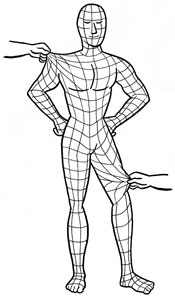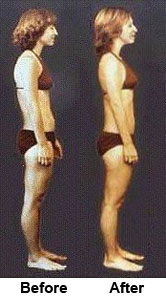Most of the joint pain people experience stems from the connective tissue of the joint, part of a seamless interconnected tissue web that contracts under strain. Rolfing® Structural Integration helps to remove the restrictions in the soft tissue that impede joint range of motion by manually softening and sculpting the body’s connective tissue or fascia three dimensionally so that the muscles, tendons and ligaments are balanced. Balanced tension throughout the body can take strain off of joints so that they are free to move without pain. Providing natural pain relief can be a benefit of Rolfing therapy and movement education proposed by a Certified Rolfer™.
The Anatomy of a Joint
A joint is actually the space between two bones, separated by fluid and cartilage, encased in soft tissue ligamentous sleeve connectors (see the white structures in the image above). Ligaments are sensory organs that evoke reflexive and synergistic activation of muscles and ensure that the bones associated with the joint travel in their prescribed anatomical tracks, prevent separation of the bones from each other, and therefore provide joint stability.
The Fascial Net
“Fascia is the organ of posture…the body is a web of fascia.”–Dr. Ida P. Rolf
Fascia is the continuous connective tissue in the body that has been likened to a complex spider web, a fish net, or the yarn in a sweater. Fascia surrounds and permeates every muscle, bone, nerve, blood vessel, and organ, all the way down to a cellular level. A tight restriction (strain caused by an injury, trauma, improper posture, etc.) in one area of the body can create tension throughout the net, causing even more tension on distant structures or joints.Restrictions in the fascial net can pull the body out of alignment, compress joints and discs, cause pain, immobility or inflexibility, and create weakness in joints to the point that they are vulnerable to injury or re-injury.
A Rolfer’s Vision
Rolfing practitioners strategically weave their hands three-dimensionally, from superficial to deep, throughout the fascial web to soften the restrictions that can pull joints out of alignment. Rolfing Structural Integration seeks to rebalance the body’s structure by gently sculpting the soft tissues that pull on bones and joints throughout the entire body. Unless the tension and strain in the soft tissue (fascia, muscles, tendons, and ligaments) is addressed, the bones will continue to be pulled out of alignment (i.e. making it appear to have one leg longer than the other or one shoulder higher than the other). Rolfing therapy uses diagnostic methods, soft tissue techniques, and movement education to treat joint restrictions that are a part of the overall body pattern of the individual to restore structural integration. The goal is to achieve balanced tension throughout the entire body, which allows the bones to fall back into their proper relationships naturally.
Rolfers are highly trained therapists in structural alignment and functional movement of every anatomical segment of the body; they are able to see the whole picture by looking at the body as a seamless interconnected relationship of parts. They use diagnostic methods to scientifically identify if the joints are moving properly and gently and artistically lessen the connective tissue restrictions that impede normal joint function, providing pain relief. With this being said, Rolfing can help with joint inflammation and pain in its goal to re-balance and integrate the whole body.
References:
1. Solomonow, M. (2007, March). Ligaments: A source of work-related musculoskeletal disorders. Structural Integration, 35(1), 18-28. Retrieved from http://pedroprado.com.br/cgi-bin/cont_ipr.cgi?backhome=1&ling=eng
2. Threlkeld, J. (1992, December). The effects of manual therapy on connective tissue. PhysicalTherapy, 72(12), 893-902. Retrieved from http://fasciaresearch.com
Gina Kilgus | Certified Rolfer | 4412 Spicewood Springs Rd #402 | Austin, TX | 78759 | Schedule a Session







